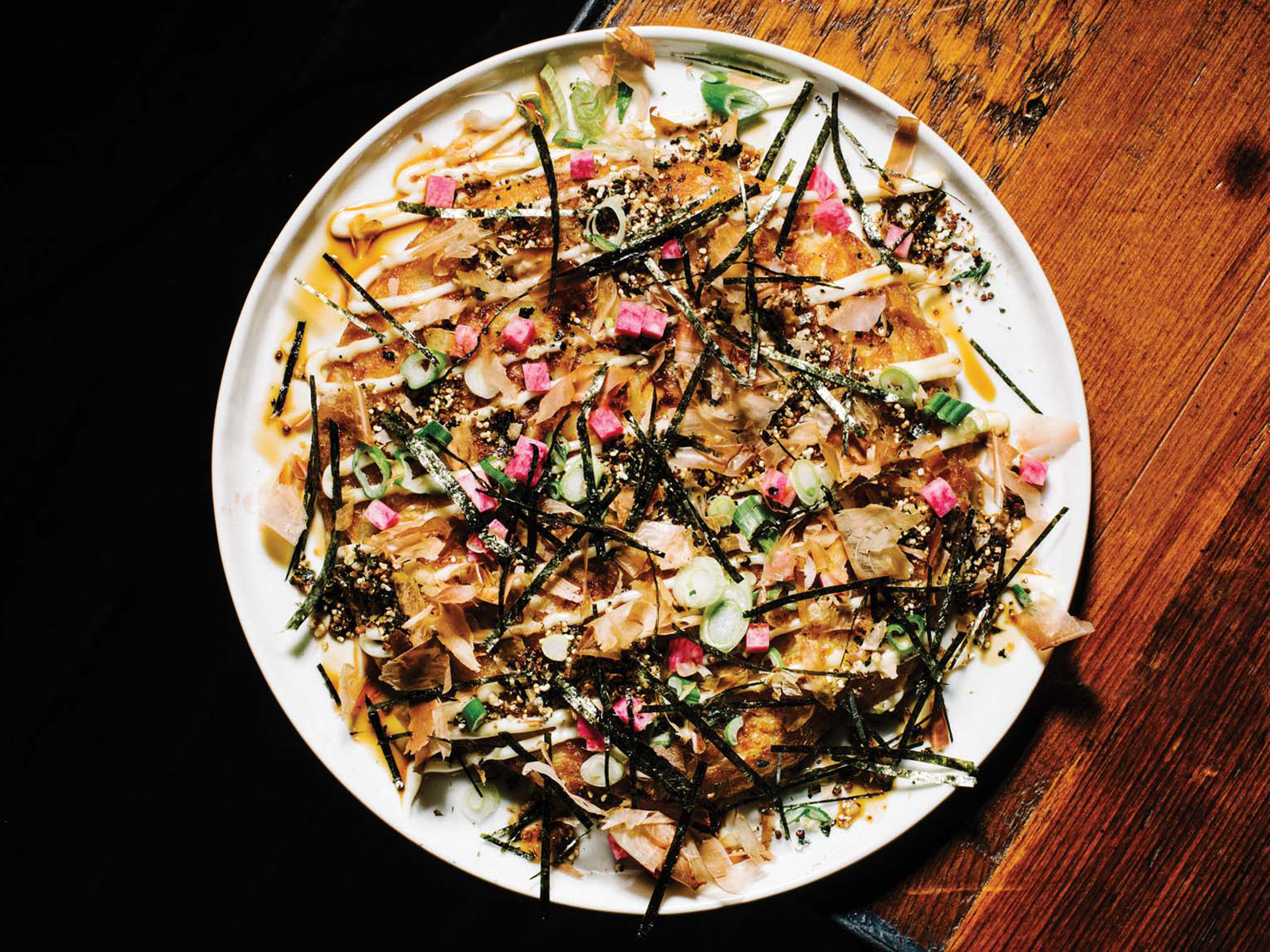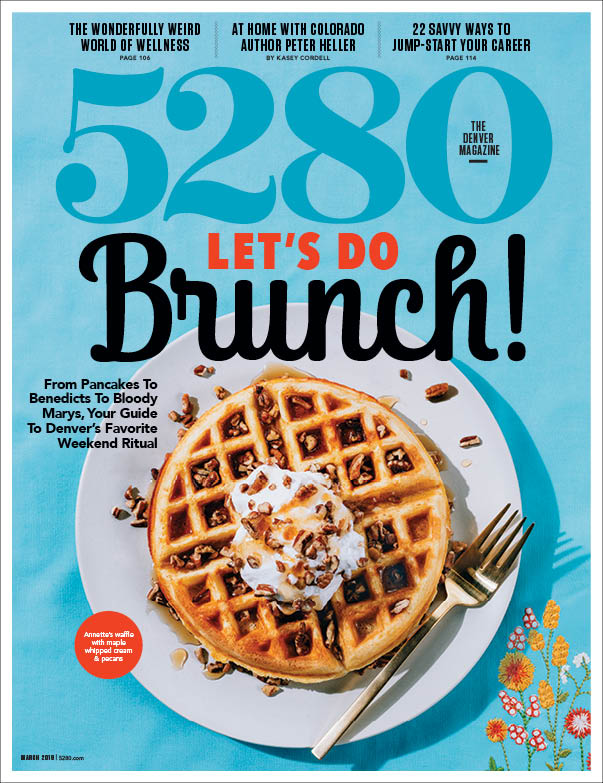The Local newsletter is your free, daily guide to life in Colorado. For locals, by locals.
The Way Back
3 Stars
- The Draw:
- Dark, cozy neighborhood spot, deft cocktails, lively fusion cooking.
- The Drawback:
- Some dishes are more confusing than coherent.
- Don’t Miss:
- El Diablo cocktail, vegetable sushi, okonomiyaki, egg with Brussels sprouts, fried delicata squash, roast chicken, pasta with chicken livers.
Walking into the Way Back one winter night, I was reminded of the boozy, welcoming murk of a Nashville speakeasy. Located in a former pub, the restaurant retains a saloonlike vibe in its front half with a grand, ebony-colored bar, high-top tables, a stamped-tin ceiling, and, down one wall, tall wooden booths. Everything—below, above, to the sides—is painted or stained on the dark side of the spectrum. Lights are kept low.
As my eyes adjusted, though, grace notes emerged. A strip of floral wallpaper runs above the booths like a Victorian awning. Pixelated images of large flowers in the dining room at the back of the space are formed by light emerging through hole-punched plywood, like huge stencils. There’s a chandelier of ferns, dangling Edison bulbs, and a blowup of a lovely verse by agrarian poet-philosopher Wendell Berry. Altogether, the Way Back’s design is a neighborly bid for coziness, an antidote to the steel and concrete vogue of most current Denver restaurants.

Chef Jon Lavelle, who most recently worked at Danny Meyer’s much-lauded Italian restaurant, Maialino, in New York City, decamped to Denver last year for the Way Back’s February Berkeley relaunch (it left its original location on West 38th Avenue in August 2017). Lavelle’s menu is a single, ever-evolving sheet with concise summaries of about 20 dishes, from snacks and small plates to pastas, entrées, and sides, spanning several cuisines. At first read, the sound of plates such as kung pao bison sparked a bit of fusion dread in me.
Our server described the food as a shareable journey, “part Asian, part Italian, and part American trashy favorites.” At least, I think that’s what she said, before she launched into a numbing, three-minute torrent of blow-by-blow descriptions that included a midstream apology for being long-winded. (I do wish servers would read their customers’ body language—things like clenched fists and rigor mortis about the face.) To be fair, another server on another evening was so adept at combining a friendly approach with precise delivery that she ought to teach a graduate degree in restaurant hospitality. Service at the packed bar on a third night was amiably efficient.

Lavelle’s energetic cooking brought to mind some recent reading I’ve done on the nature of physics (The Big Picture by Sean Carroll, which I highly recommend). In Lavelle’s best dishes, flavors and ingredients find stable orbit around a central premise, while in others they collide or fly off into space like particles surfing the entropic expiry of the universe. Sometimes, both phenomena happen at once.
But his approach is (mostly) solid, spirited, and clever. House-made potato chips are delicate and delectable, and the Farmer’s Market Sushi, for which vegetables are transformed into nigirilike pieces that mimic rice and fish, delivered meditative one-bite satisfaction, as sushi should. On one visit, a tight bundle of nori-wrapped spaghetti squash was brushed with fish sauce and chile oil; on another, Lavelle performed similar tasty trickery with watermelon.
A small-plate ode to beets included pickled plums, ricotta, and roasted and dried beets; the last approached the dense, sticky texture of dates. My dining companion found the dish too busy, but it was the first original dish done with beets I’ve eaten in a long time. And a plate of fried delicata squash deserves legislation declaring it an official improvement on the onion ring. Crunchy batter—more sturdy Jersey Shore than fine Kyoto tempura—enrobed sweet, meaty, just-cooked squash, the pile spotted with mayonnaise made tangy with XO sauce.
A bit of disorder appeared in a main dish of sirloin steak with kimchi, cucumber, and charred onion. For the kimchi, Lavelle pickled chunks of crisp pear (instead of cabbage) in the funky, sour, Korean style. The meat was aggressively, but deliciously, crusty—rare inside and tasting of dry-aging. There were wedges of charred English cucumber and slices of radish. But Lavelle had also smeared the plate with a layer of yogurt that belonged in a parallel universe. It took me several bites to decide that I liked the beef-and-pickles combination so much I didn’t care.

Two pasta dishes, however, showed the contrast between coherence and chaos. The first, spaghetti with chicken livers and shiitake mushrooms, was pure harmony of umami flavors containing no livery grit at all; the fresh, chitarra-style noodles had the perfect chew. In fact, it approached my pasta ideal. On the other hand, pappardelle tossed with cabbage, roasted onion, chiles, and cilantro was vaguely tasty without making any sense. Ingredients wandered in search of flavor bonds; the cilantro was an intrusion; and the thick onion pieces were undercooked.
Along the journey were a few outright kitchen errors. A dim-sum-ish appetizer of turnip cakes, seared almost to burnt, were mushy when they needed to be firm. The batter on a platter of Southern-style fried chicken looked robust but was too delicate, flaking off the thigh and leg pieces as we ate. Mandarin slices in a dessert called Citrus were unpeeled and pithy, served under a slick of pumpkin seed oil that unfortunately had the look of used motor oil. And the addition of candy-sweet persimmon to an already odd dish of swordfish, cauliflower, and cauliflower purée was jarring.
But few of these dishes (except that dessert) were actual failures, and most of what we ate at the Way Back was very good. The kung pao bison was a great match for cocktails: Thin strips of meat were bathed in chile oil, with crunch and pop coming from celery, peanuts, and pickled mustard seeds. The flattop-grilled “okonomiyaki” (a pancake from Osaka) was tighter and thinner than varieties I have had in Japan, but it was also crisp-edged and savory. It had a smooth, almost gooey rice flour interior set off by a sprinkle of fried grains (amaranth, quinoa), diced watermelon radish, and ribbons of eggy mayo that looked as if they’d been squeezed straight from a Kewpie bottle, a fun nod to Japanese street-food style. The roast chicken breast was a paragon—cooked exactly right, served with a buttery, chicken-y sauce, and complemented by walnuts and tart apple. We devoured, in a matter of seconds, an appetizer of sous vide egg with Brussels sprouts and a ’nduja-flavored vinaigrette.
This sort of brightly flavored, shareable food goes well with reasonably priced $10 to $12 cocktails from expert mixologist (and co-owner) Chad Michael George. There’s a page each of “Way Back Originals” and “Favorite Classics” on the menu, all drinks helpfully described by flavor and style. The originals are interesting without being wacky or confused. The KC Cocktail, for example, for the whiskey sour lover, is properly tart with extra depth from vegetal Cynar and tannic interest from a red wine floater. The classic El Diablo (tequila, ginger beer, lime, and, of all things, cassis) is near perfect: Tightly bound flavors are borne along on mild fizz in a sort of Tijuana mule.
As a neighborhood restaurant, the Way Back offers a warm welcome; I wish I lived closer to it. As a destination, it’s well worth a visit too because Lavelle is exploring a fascinating line between creativity and confusion—and clearly has the talent to stay on the right side of it.









